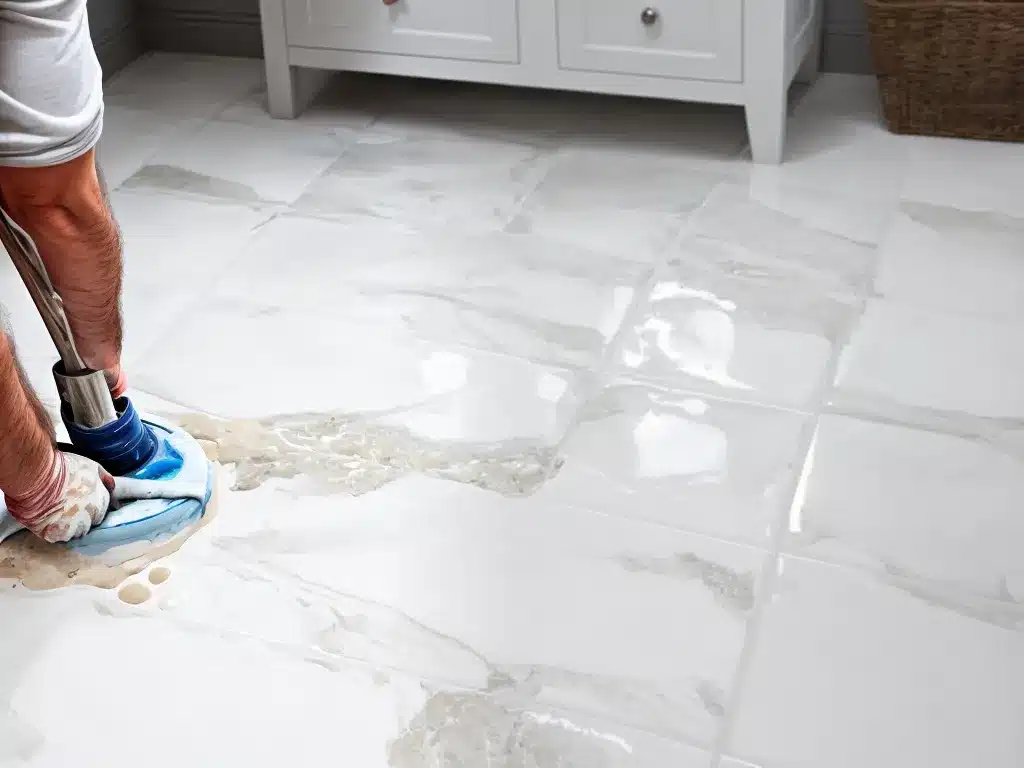Grouts that are dingy, stained, or discolored take away from the clean look of your tiles. Over time, grout can absorb dirt, grime, and moisture that discolors it from its original bright white. While you may be tempted to regrout the entire surface, there are several simple solutions to clean and whiten grout without taking on big messy projects.
Why Grout Discolors Over Time
Grout is porous and absorbs liquids and dirt over time. There are a few main causes of discolored grout:
-
Moisture – Excess moisture from spills, steam from showers, and humidity can seep into the grout. This allows mold and mildew to grow, showing up as black spots.
-
Dirt and Grime – Normal dirt and grime from feet, soap scum, and cleaning chemicals can work its way into the pits and pores of the grout. This leads to a dingy grey color.
-
Improper Cleaning – Using harsh cleaners on grout can actually stain it over time. Bleach and other chemicals can react with grout and change its color permanently.
Knowing the root causes of discoloration is key to choosing the right solutions to whiten grout effectively.
Cleaning vs. Regrouting
When facing dingy grout, you have two options:
-
Clean the existing grout – This saves time and money by avoiding a full regrouting job. Cleaning can often whiten grout to like-new condition with the right methods.
-
Regrout – In severe cases of cracking, flaking or missing grout, a full regrouting may be needed. This requires scraping out all old grout and replacing with new.
Cleaning grout is always the first step and may do the trick on its own. If you find cracks, pitting, or chunks of grout missing after deep cleaning, a regrouting is likely needed.
6 Simple Solutions for Whitening Grout
1. Mix Baking Soda and Vinegar
Baking soda and vinegar is a natural cleaning duo. The reaction of the two helps break up dirt and stains. To use:
- Mix 1/2 cup baking soda with 1/2 cup vinegar into a spreadable paste.
- Use an old toothbrush to spread the paste onto stained grout.
- Let it sit for 3-5 minutes then scrub vigorously.
- Rinse thoroughly with water.
Repeat as needed for tough stains.
2. Use Hydrogen Peroxide
Hydrogen peroxide is another mild but effective cleaning agent. It naturally whitens and disinfects. To use:
- Pour undiluted 3% hydrogen peroxide into a spray bottle.
- Lightly spray on grout and let bubble for 2-3 minutes.
- Scrub with a stiff bristle brush and rinse.
Be sure to wear gloves as hydrogen peroxide can irritate skin.
3. Make a Baking Soda Paste
For a gentle abrasive paste, mix baking soda with just enough water to form a thick spreadable paste. To use:
- Add 1/4 cup baking soda to a small bowl.
- Add water 1 teaspoon at a time, mixing until a thick paste forms.
- Use a grout brush or old toothbrush to spread paste on grout lines.
- Let sit for 5 minutes then scrub.
- Rinse thoroughly with water.
Baking soda naturally whitens and deodorizes grout.
4. Steam Clean Grout
For cleaning large tile areas, a steam cleaner is an effective grout whitener. The pressurized hot steam helps lift stains and kill bacteria and mold. To use:
- Fill steam cleaner reservoir with cleaning solution according to manufacturer instructions.
- Run steam cleaner over entire area, concentrating on grout lines.
- Use detail attachments to directly spray grout lines.
- Wipe with clean cloth when finished.
Repeat as needed for heavy staining.
5. Use a Grout Whitening Pen
Specialty grout pens contain bleaches and cleaners designed to whiten grout. They come with an applicator tip that easily directs the product into the grout lines. To use:
- Shake pen well and press tip down to start flow.
- Run tip along the length of each grout line, applying a thin even coat.
- Let it sit per product directions, usually 5-10 minutes.
- Scrub with a stiff bristle brush.
- Rinse with clean water.
Be sure to follow manufacturer’s instructions for maximum results.
6. Regrout Discolored Areas
For small areas that don’t whiten with other methods, regrouting may be needed. This involves scraping out the old grout and replacing just those sections. To regrout:
- Use a special grout saw blade or rotary tool to remove old grout.
- Vacuum dust and debris.
- Apply new grout matching old.
- Wipe away excess before drying.
- Seal grout once fully cured.
Target regrouting only where needed to avoid large-scale projects.
Prevent Discoloration in the Future
Once your grout looks white and clean, maintain it by:
-
Sealing annually with a grout sealer. This creates a protective barrier.
-
Using a squeegee after showering to prevent moisture buildup.
-
Mixing 1/2 cup vinegar to 1 gallon water for regular cleaning. Avoid harsh cleaners.
-
Addressing any leaks immediately to prevent moisture issues.
With proper care, your grout can stay white and fresh-looking for years to come. Try these simple solutions first before undertaking a big regrouting project. A little cleaning can often bring back the bright white grout you love.







